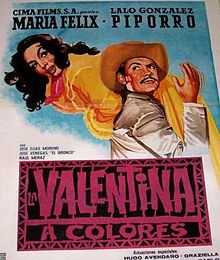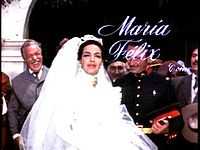La Valentina (1966 film)
| La Valentina | |
|---|---|
 Theatrical release poster | |
| Directed by | Rogelio A. González |
| Produced by | Gregorio Walerstein |
| Screenplay by | José María Fernández Unsáin |
| Story by |
José María Fernández Unsáin Gregorio Walerstein Eulalio González |
| Based on |
"La Valentina" (public domain) |
| Starring |
María Félix Eulalio González |
| Music by | Manuel Esperón |
| Cinematography | Rosalío Solano |
| Edited by | Rafael Ceballos |
Production company |
Estudios San Ángel Cima Films |
| Distributed by | Azteca Films |
Release dates |
|
Running time | 99 minutes |
| Country | Mexico |
| Language | Spanish |
La Valentina is a 1966 Mexican romantic comedy film directed by Rogelio A. González, produced by Gregorio Walerstein, and starring María Félix and Eulalio González in the leading roles.[1] The supporting cast features José Elías Moreno, José Venegas, and Raúl Meraz. The film is a dramatization of the Mexican Revolution corrido of the same name.[1]
Plot
In early 20th century Mexico, in the midst of the Mexican Revolution, the beautiful yet feisty Valentina Zúñiga marries an unnamed serviceman. Though she is part of the rural upper class, Valentina is a fervent supporter of the Revolution. At the same time but in another place, a smuggler named Genovevo Cruz García sells defective arms to the federal Mexican army.
During Valentina's wedding night, gunshots are heard outside her bedroom window. This frustrates her, as she believes it is a waste of ammunition. Her newlywed husband, however, believes that the guns are shot in celebration to their wedding. As he approaches the bedroom balcony to stop the gunshots, Valentina's husband is shot multiple times and killed. The next day, at the burial of her husband, Valentina desires vengeance.
When Genovevo's deceit becomes known, since his faulty arms were the cause of multiple casualties, the federals decide to execute him by a firing squad. As he is executed and falls to the ground, an elderly couple ask for his body so that they may give him a Christian burial. Genovevo's body is driven away on the couple's donkey and it is later known that the execution was false. Federal military captain Luis Benítez, the man who headed the firing squad, tells Genovevo that he was shot with rubber bullets and saved from death for a reason. Benítez starts to explain that he has fallen in love with Valentina Zúñiga, ordering Genovevo to kidnap her for him. Genovevo agrees but bursts into laughter. Responding to Genovevo's laughter, Benítez states that Valentina is worth the dangerous attempt of kidnapping, as she is beautiful, affectionate, and sweet.
Genovevo therefore travels to Valentina's village, concocting a clever plan to kidnap her. As Valentina and her father and brothers are short of ammunition, they send for Genovevo, who quickly agrees to sell them arms on the condition of taking Valentina with him to the place where his merchandise is located. Her father refuses but Valentina decides to go and she is accompanied by her two brothers. Upon arrival at the location of Genovevo's merchandise, Valentina's brothers fall into Genovevo's trap and he successfully kidnaps her.
Cast

- María Félix as Valentina Zúñiga
- Eulalio González as Genovevo Cruz García
- José Elías Moreno as Don Juan Zúñiga
- José Venegas as Epigmenio Zúñiga
- Raúl Meraz as Captain Luis Benítez
- Graciela Lara as Lupita
- Carlos Agostí as Valentina's husband
- Víctor Alcocer as the federal Colonel
- Ricardo Carreón as the federal Sergeant
- Carlos León as Melitón Zúñiga
- Juan Ferrara as a federal soldier
- Jorge Lavat as Erasmo
- Victor Sorel as Bedulo
- Hugo Avendaño as a revolutionary singer
- Graziella Garza as a revolutionary singer
- Manuel Dondé as the man giving the eulogy (uncredited)
- Manuel Vergara as the prisoner at the betting (uncredited)
- Manuel Alvarado as the bartender (uncredited)
- Mercedes Carreño as the maid of the Zuiñga household (uncredited)
- Agustín Isunza as the corrido vendor (uncredited)
- Roberto Meyer as Don Quintín (uncredited)
Production
According to Eulalio González, María Félix wanted to star with him in a comedy film, and therefore, the film came to be.[2] The film's script was exclusively written by González so his "Piporro" character could alternate with María Félix.[2] The film's background is the Mexican Revolution, an armed conflict between the government and the peasantry during the early 20th century. Hints of the story's setting in the film suggest that the film took place in the state of Jalisco, since Félix's character remarks her hometown as Tepatitlán,[3] and a song in the film mentions Guadalajara.[4]
Release
In Mexico, the film premiered on February 10, 1966, in the Mariscala and México theaters in Mexico City.[5] Its American premiere was on May 1, 1966 in the Million Dollar and United Artists theaters in Los Angeles, California.[6]
Critical response
One contemporary critic, writing for the Mexican Política magazine, criticized the film as "tragically stupid and revealing of the hallucinating level of our commercial cinema."[7]
Accolades
| Award | Category | Name | Outcome |
|---|---|---|---|
| Silver Goddess Awards[8] | Best Actress in a Minor Role (Mejor actriz de cuadro) | Graciela Lara | Nominated |
Music
- "La Valentina" (public domain) performed by Hugo Avendaño and Graziella Garza.
- "Tengo ganas" written and performed by Eulalio González.
- "El güero aventao" written and performed by Eulalio González and María Félix.
- "La norteña" written by Eduardo Vigil y Robles and performed by Hugo Avendaño and Graziella Garza.
References
- ↑ 1.0 1.1 García Riera, Emilio (1992). Historia documental del cine mexicano: 1964-1965. Universidad de Guadalajara. pp. 216–218. ISBN 9688955418.
- ↑ 2.0 2.1 "A documentary of Piporro's career.". Retrieved 23 September 2011.
- ↑ Valentina (María Félix) reveals her hometown when Genovevo (Eulalio González) nicknames her the "Rosa de Xochimilco", and Valentina steps on him reminding him that she is the "Rosa de Tepatitlán". After they flee the town in disguise Genovevo once again says "Nice work, my "Rosa de El Bajío", and Valentina again corrects him and says "of Tepatitlán".
- ↑ "El güero aventao" by Eulalio González.
- ↑ "Peliculas del Piporro". Retrieved 13 August 2012.
- ↑ Los Angeles Times, Issue May 1, 1966.
- ↑ Política: quince dias de México y del mundo, Volume 6, Issues 133-143. 1965. p. 52.
- ↑ Política: quince días de México y del mundo. 1967. p. LVI.